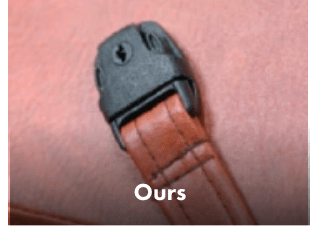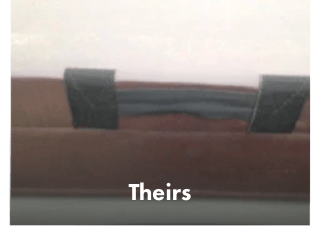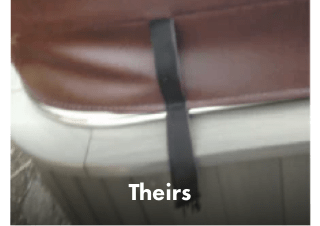Why do spa covers get waterlogged?
Spa covers often become waterlogged due to their design and function. Beneath the waterproof vinyl cover lies a sealed plastic bag enclosing expanded polystyrene (EPS) insulation. This interior setup aims to keep UV radiation at bay while preventing rainwater from entering the tub.
However, the open mesh underside allows warm, sanitized spa water—usually around 103°F—to penetrate over time. The bromine added for sanitation also contains chlorine, which contributes to this issue by affecting materials inside the cover as well.
Preventing Spa Cover Water Absorption
Preventing spa cover water absorption starts with understanding its structure. The vinyl exterior protects against UV radiation and rain, but it's not fully sealed. Over time, water vapor from the hot tub at 103°F infiltrates through seams or zippers into the Expanded Polystyrene (EPS) insulation inside.
Regularly inspecting for damage and keeping chemicals balanced can limit this absorption. Using a high-quality myspacover designed with superior seals and thicker EPS panels further reduces vulnerability to moisture infiltration, thus prolonging lifespan significantly.
Recognizing Signs of a Saturated Spa Top
Waterlogged spa covers often appear saggy and heavy. The foam inside gets saturated, compromising insulation. Myspacover experts note that a good indicator is difficulty lifting the cover due to excess weight.
This usually means it has absorbed a lot of water, making it ineffective in maintaining heat. Another sign is mildew or mold growth on the underside. These fungi thrive in moist environments and can signal internal moisture issues within the cover itself.
If you notice unusual odors emanating from your hot tub area, this can also point to trapped moisture breaching through weakened vapor barriers.
Maintaining Proper Chemical Levels in Spas
Maintaining proper chemical levels is crucial for spa health. Test water two to three times weekly to ensure it remains balanced. Unbalanced chemicals can lead to microbial contamination, making the water unpleasant and unsafe.
Use appropriate spa filters like Neo-Pure or Filbur, compatible with your hot tub model, as they trap contaminants effectively. Regularly clean these filters: rinse them weekly, perform a monthly chemical clean, and do a quarterly soak. Replace your filter annually since clogged debris reduces filtration efficiency over time.
Proper maintenance prevents murky water and extends the lifespan of both the spa cover from MySpaCover and mechanical components inside your hot tub.
Spa covers get waterlogged due to damaged seams or poor-quality materials. Over time, exposure to the elements weakens these components, allowing moisture to seep in. Once inside, water accumulates and compromises the cover's effectiveness.
Additionally, constant temperature fluctuations expand and contract the foam core, creating tiny pockets where water can settle. It's essential for spa owners to inspect their covers regularly and opt for high-quality options like those offered by myspacover.com designed with durability in mind.
Our Quality
It is easy for a website to claim they have the best quality but at MySpaCover we guarantee it. We utilize only the highest quality materials and the most sophisticated processes to offer the best covers available online. Here is how our covers compare to the competition:
MYSPACOVER

Our heavy-duty handles come standard and are double stitched using marine grade vinyl to ensure the highest durability and most attractive aesthetics.

Our standard straps are double stitched and are also produced with marine-grade vinyl.

We double stitch every seam and hinge to ensure your spa cover can be used for years to come.
Other Guys

Their cheap handles are more prone to wear and tear and are known to rip off within the first two years plus the appearance speaks for itself.

Our competition uses low-quality straps that are prone to breakage and often times do not match the color of the spa cover.

Their use of single stitching and exposed shells can ultimately cause cracking and heat loss, costing you more on your electric bill.
The Underside
The underside of a spa cover is often overlooked. However, this is the material that is in constant contact with high temperatures and the chemicals in your spa. The life of your spa cover depends on a high-quality spa underside. We don’t cut corners like the other guys so you can trust that our 6 mil plastic wrap is vapor sealed to the core and will keep the heat out.
MySpaCover utilizes an 11oz PVC coated poly that, after years of rigorous testing, has proven to be the best possible material to withstand constant high temperates and chemical exposure.
Beware of mesh bottoms used by competitors as this type of material is meant to cut costs and is prone to failure.
We’ve found a few great alternatives to your selected spa cover that can reach you even quicker!
Here are the closest available alternatives based on your preferences.